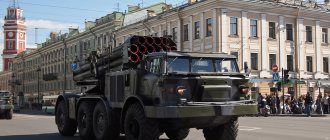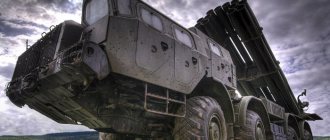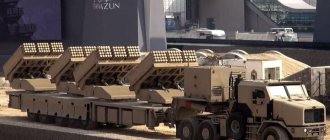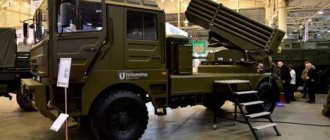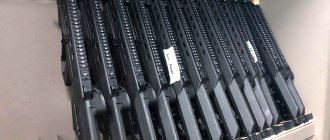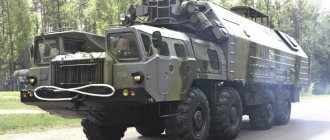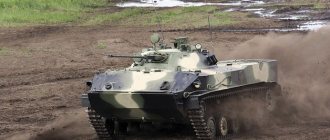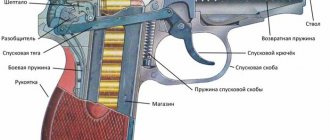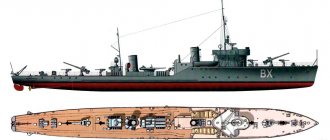MLRS 9K57 Uragan - Video of shooting
Taking into account the adoption of the M-21 Field Rocket System in 1963, the Tula State Research Institute of Precision Mechanical Engineering, on its own initiative, in 1963-1964 carried out exploratory work in order to study the possibility of creating a more powerful system in terms of the amount of explosive in the salvo, with a longer range , with the help of which it would be possible to carry out operational combat missions at ranges ranging from 10 to 35-40 km.
In June 1964, the “Project of a field MLRS of the Uragan system with a projectile range of 35 km” was sent to the Ministry of Mechanical Engineering for consideration. The project proposed a system with high maneuverability, a travel speed of up to 70 km/h, high maneuverability and the ability to open salvo fire in a short time, which could be used to combat manpower, both openly located and hidden in field-type structures , fire weapons, tanks, nuclear and chemical weapons and other enemy targets and objects at ranges of up to 35-40 km.
Based on the order of the Ministry of Defense Industry (MOP), dated December 28, 1966, in 1967 the research work “Creation of a high-precision multiple launch rocket system “Uragan” (NV-121-66) was started. The work was completed in December 1967 with confirmation of the possibility of obtaining the specified characteristics, carrying out theoretical studies, bench tests of engines, a mechanism for delaying the deployment of the stabilizer, a separation mechanism, aerodynamic blowing and firing of model projectiles, and was recommended for development work (R&D).
The results of the work carried out were approved by subsection No. 1 of section 1 of the Scientific and Technical Council of the IOM and the topic was recommended for carrying out development work after eliminating the noted deficiencies. There is also other data according to which in 1967 the research project was completed and a preliminary design of the complex was developed, confirmed by bench tests of the projectile and launcher units, as well as firing tests with model projectiles.
The “Hurricane” complex with the given characteristics was superior to the standard “Grad” system and significantly superior to well-known domestic models, therefore it was recommended for development work. Based on the order of the Minister of Mechanical Engineering and the Minister of Defense Industry of February 27, 1968 No. 18/94 on the basic requirements of the military. 64176 (ref. no. a/774378 dated March 30, 1968) in the third quarter of 1968. The preliminary design of the Uragan complex was completed.
The Uragan complex was designed to suppress and destroy enemy manpower and equipment in areas of concentration at ranges of up to 35 km.
The complex was developed consisting of:
— unguided missile; - combat vehicle; — command vehicle; — transport-charging machine.
For the Uragan complex, the possibility and feasibility of creating a high-explosive fragmentation warhead, a warhead with a special filling, as well as cluster fragmentation warheads was shown. These combat units were recommended for development work.
Regarding combat units for remote mining of anti-personnel and anti-tank mines and fire units, it was necessary to carry out research work with the manufacture and testing of prototypes. As a result of the auto project, the possibility of using radio-technical zeroing was shown in order to increase shooting accuracy. In the case of using radio-technical zeroing, the firing accuracy of the Uragan complex could be obtained no worse than ±1000 m. The radio-technical zeroing vehicle could be created either as an independent command vehicle or as a modification of a combat vehicle. In the latter version, the number of guides had to be reduced to accommodate radio-technical sighting equipment. The question of the feasibility of creating a radio-technical mounting in the Uragan complex required further study.
The preliminary design of the Uragan complex was approved by the 2nd Main Directorate (conclusion ref. No. I-6226 dated 27.2.68) and the decision of subsection No. 2 of section No. I of the Scientific and Technical Council of Minmash (ref. I-6224 dated 4.I2.68) and recommended for development work. There is also data according to which, in order to eliminate these shortcomings discovered during research, on the basis of order MM and MOP No. 18/94 in 1968, a preliminary design of the Uragan multiple launch rocket system was developed and in September 1968 the work was recommended for implementation Design and development work (from a document from TULGOSNIITOCHMASH (Tula) from the early 70s).
In 1969 - early 1970, work was carried out to draw up and adjust the tactical and technical requirements for development work: “Army multiple launch rocket system” “Grad-3” (as amended in early 1970, “Hurricane”). This is probably TTT No. 0010 of military unit 64176. It should have included a combat vehicle, a transport vehicle, a command vehicle, and arsenal equipment. The following types of warheads were proposed: high-explosive (with a specified fragmentation of the hull), cluster fragmentation warheads, and cluster warheads for remote mining of terrain. The decision to develop other types of warheads (cumulative, incendiary, agitation and specially loaded) was to be made by the Ministry of Defense and the Ministry of Mechanical Engineering based on the results of the preliminary project in the second quarter of 1970. The design of the projectiles was to use a single solid fuel jet engine for all types of warheads with an unregulated nozzle(s) throughout the entire operating temperature range. Replacement nozzles were not allowed. The ZIL-135LM chassis was proposed as a base. At the preliminary design stage, options for combat and transport vehicles on the chassis of the MT-S tracked transporter-tractor were to be worked out (see the TTT version for the Grad-3 (Hurricane) MLRS and technical specifications for the modification of the command vehicle for the Grad-3 system 3" ("Hurricane"). The number of guides was set to 20 when using the ZIL-135LM chassis and 24 when using the MT-S chassis. However, their exact number had to be clarified based on the results of consideration of the preliminary design. The option was also considered as a base for the transport vehicle on the wheeled chassis of a Kraz-253 truck.
Work on the creation of the “Hurricane” system was carried out on the basis of Decree of the Council of Ministers of the USSR dated January 21, 1970 No. 71-26 (Order of the Minister of Mechanical Engineering dated January 28, 1970 No. 33). In January-February 1971, in order to test activities related to work to increase the firing range, firing of Uragan system shells from a ballistic installation on an ML-20 carriage in the amount of 30 pieces was planned. Projectiles with three types of fins were to be supplied:
— knife type, with a feather thickness of 7 mm, and the opening of the feathers at an angle of 90° to the longitudinal axis of the projectile (probably meant up to an angle of 90°); - according to the Grad projectile design; - combined (combining the tail of a Grad projectile and a knife type).
When TsAGI tested variants of projectiles with three types of fins, positive results were obtained. The stability margin was ~12%. The letter dated April 26, 1972 mentions work on fiberglass pipes for the guide packages of the 9P140 and 9P139 combat vehicles. In 1972, TulgosNIItochmash carried out work on the topic NV2-154-72 “Single-channel angular stabilization system for Grad and Hurricane-type projectiles” (start of work - 1st quarter of 1972, completion - 2nd quarter of 1973).
In 1972, research into the design of a single-channel angular stabilization system was carried out in two directions:
— based on an angular velocity sensor using gas-dynamic actuators; - based on a contact angle sensor with powder pulse actuators.
According to the TulgosNIITochmash report on work in 1972, in 1972 theoretical calculations, modeling on analog electronic machines, and experimental laboratory studies of a single-channel angular stabilization system and its elements for unguided rockets of the “Grad” and “Uragan” types were carried out: The basic requirements for system and its elements.
The single-channel angular stabilization system included an angular displacement sensor, an electronic converter unit, and gas-dynamic (or pulse) type actuators. It was determined that the use of a single-channel angular stabilization system in projectiles such as “Grad” and “Uragan” improves their characteristics in terms of firing accuracy by 1.5-2 times. Drawings were developed for the elements of the angular stabilization system, prototypes were made and tested in laboratory conditions. At the time of compilation or submission of the report, a batch of blocks of a single-channel angular stabilization system was being produced for flight testing.
MLRS 9K57 "Hurricane" fires at Mujahideen positions in Afghanistan
In 1972, on the basis of the order of the head of the 2nd Main Directorate of the Ministry of Mechanical Engineering dated December 20, 1970 No. 17, TulgosNIItochmash carried out research work on the topic “Research on ways to create long-range projectiles for systems such as “Grad” and “Hurricane” (topic NV2-110 -71g). In accordance with the target objective of the topic, theoretical and experimental work was carried out, which demonstrated the possibility of increasing the firing range of projectiles of the Grad and Uragan systems through the use of durable materials for the body and high-impulse fuels. In 1972, it was recommended that development work be carried out to develop the Uragan system (obviously meaning the development of a projectile or projectiles) with an increased firing range of up to 40 km.
In 1972, factory testing was completed, and the system was presented for field testing in the following composition:
— unguided rockets with high-explosive (100-105 kg) and cluster fragmentation warheads (80-85 kg); - 9P140 combat vehicle on the ZIL-135LM chassis; — transport-loading vehicle 9T452 on the ZIL-135LM chassis; - arsenal equipment.
At the stage of factory testing, system characteristics were obtained that satisfied the basic tactical and technical requirements:
— the maximum firing range of shells with a high-explosive warhead is 34 km, with a cluster warhead – 35 km;
accuracy of fire: - projectile with a high-explosive warhead: in range Vb/X = 1/197, in direction Vb/X = 1/174. - projectile with a cluster warhead: in range Vb/X = 1/261, in direction Vb/X = 1/152.
The reduced area of destruction by a cluster warhead, provided that the combat elements approach the target at 85-90°: - openly located manpower (Eud. = 10 kgm/cm2) - 22090 m2 - military equipment (Eud. = 135 kgm/cm2) - 19270 m2
The reduced area of destruction by a high-explosive warhead: military equipment (Eud = 240 kgm/cm2) – 1804 m2; — Funnel size: diameter 8m, depth 4.8m.
The number of guides for the combat vehicle is 18; salvo time - 9 s, transportable ammunition load on the transport-loading vehicle - 1 set. Chief designer of the combat vehicle Yuri Nikolaevich Kalachnikov.
According to data dated 1986, the Uragan MLRS (in the source, BM-27 combat vehicles) were in service not only in units of the Soviet Army, but also in the Syrian army, and according to some data in the Libyan army.
Currently, the system is in service with the armies of Russia, Kazakhstan, Belarus, Ukraine, Yemen and Syria.
The Uragan MLRS was widely used in combat operations in Afghanistan, during which it was used to engage area targets, especially for launching surprise attacks from behind various natural shelters, as well as for fire support during tactical helicopter raids and operations to destroy ground targets. goals. In the early 80s, it was deployed and used by the Syrian military at the initial stage of the war with Israel. The system was used in Transcaucasia (as of 1991), by Russian federal troops in the Chechen Republic and during the Georgian-South Ossetian conflict of 2008 by Russian troops. In 2014-2015, the system was used by the Armed Forces of Ukraine (AFU) against militias in the southeastern part of Ukraine.
Compound
The Uragan MLRS includes the following combat weapons:
— Combat vehicle BM 9P140 — Transport-loading vehicle 9T452 — Missiles — Automated fire control complex (AFC) 1V126 “Kapustnik-B” — Training facilities — Vehicle for topographic survey 1T12-2M — Radio direction-finding meteorological complex 1B44 — Special arsenal set equipment and tools 9F381
The 9P140 combat vehicle is built on the chassis of a four-axle ZIL-135LMP all-terrain vehicle (8x8 wheel arrangement). The artillery unit includes a package of sixteen tubular guides, a rotating base with guidance mechanisms and sighting devices, a balancing mechanism, as well as electrical and hydraulic equipment. Guidance mechanisms equipped with power drives make it possible to direct the package of guides in the vertical plane from 5° to a maximum elevation angle of +55°. Horizontal guidance angle ±30° from the longitudinal axis of the machine. To increase the stability of the launcher when firing, two supports are mounted in the rear of the chassis, equipped with manually operated jacks. Missiles can be transported directly in the guides. The BM is equipped with communications equipment (radio station R-123M) and a night vision device.
Tubular guides are smooth-walled pipes with a screw U-shaped groove along which the pin of the rocket slides when fired. This ensures the initial spin of the projectile to give it the necessary stability in flight. When moving along the trajectory, the rotation of the projectile is supported by the blades of the drop-down stabilizer, installed at a certain angle to the longitudinal axis of the projectile. A salvo of one combat vehicle covers an area of more than 42 hectares. The main method of shooting is from a closed position. It is possible to fire from the cockpit. BM 9P140 crew - 6 people (in peacetime - 4): BM commander, gunner (senior gunner), driver, crew number (3 people).
The package of guides is mounted on a cradle - a welded rectangular platform (see layout diagram). The cradle is connected to the upper machine by two semi-axes, around which it rotates (swings) when aimed at the elevation angle. The totality of the package of guides, the cradle, a number of parts and assemblies of the locking mechanism, the ignition system, the sight bracket, etc. makes up the swinging part. The rotating part of the BM serves to give the package of guides the required azimuth angle and includes a swinging part, an upper machine, balancing, lifting and turning mechanisms, shoulder straps, a gunner's platform, a manual guidance drive, a locking mechanism for the swinging part, a hydraulic lock for the swinging part, a locking mechanism for the rotating part . The balancing mechanism serves to partially compensate for the moment of the weight of the swinging part and consists of two torsion bars and fastening parts. The lifting and rotating mechanisms are used to guide the package of guides along the elevation angle and in the horizontal plane. The main method of guidance is by electric drive. In case of failure and during repairs, a manual drive is used. Locking mechanisms secure the moving parts of the unit when moving. The hydraulic lock of the swinging part prevents the aiming from being lost in the elevation angle and relieves the load on the lifting mechanism when firing.
The combat vehicle is equipped with a D726-45 mechanical panoramic sight. The standard PG-1M gun panorama is used as a sighting and goniometric device in the sight.
The BM 9P140 launch system provides:
- safe operation of the crew serving the BM during firing, - conducting single and salvo fire when the crew is in the cockpit, - conducting single and salvo fire when the crew is in shelter at a distance of up to 60m from the BM, - firing when the main circuit blocks fail shooting and power sources.
The launch system provides the possibility of salvo firing at a constant rate (all 16 missiles are launched at a rate of 0.5 s), as well as the so-called. “ragged” rate of fire (the first 8 missiles at a rate of 0.5s, the remaining 8 missiles at a rate of 2s). Thanks to the use of a “ragged” rate of fire, it is possible to significantly reduce the amplitude and frequency of BM vibrations, and, consequently, improve the accuracy of fire.
The launcher is loaded using the 9T452 transport-loading vehicle, developed on the same wheeled chassis as the combat vehicle. Each TZM 9T452 carries 16 rockets and provides loading and unloading without special preparation of the position, incl. from any transport vehicle, from another vehicle and from the ground. The reloading process is mechanized and takes 15 minutes. The lifting capacity of the TZM crane is 300 kg.
The TZM equipment consists of a frame, a tray with a rammer, a crane, cargo trolleys, an operator platform, a load-handling device, a docking device, a crane rotation gearbox, a rod, an alignment mechanism, electrical equipment, and spare parts. The tray with the rammer is a folding beam along which the pusher with the rocket moves. The alignment mechanism is designed to align the axis of the rocket located in the tray with the axis of the guide pipe. The left and right carts are designed to accommodate missiles. The TZM has three electric drives: lifting (lowering) missiles, turning the crane, sending missiles into the guides.
The BM is loaded from the upper tier in the following sequence: lift the missile and place it in the tray, unhook the load-handling device and send the missile into the guide (see the diagram of the relative position of the BM 9P140 and TZM 9T452 during loading and the diagram of the location of the BM battery at the firing line).
A special feature of the four-axle wheeled chassis of the ZIL-135LMP vehicle is the location of the power plant behind the four-seat crew cabin. This power plant consists of two V-shaped eight-cylinder ZIL-375 carburetor engines. Each of these engines at 3200 rpm develops a maximum power of 180 hp. With. The transmission is made according to the on-board scheme: the wheels of each side are driven by an independent engine through a separate gearbox, transfer cases and final drives. The wheels of the first and fourth axles are steerable and have independent torsion bar suspension with shock absorbers. The wheels of the middle axles are close together, do not have elastic suspension and are rigidly attached to the frame. The machine is equipped with a centralized tire pressure regulation system. The vehicle has very high maneuverability and good speed characteristics. When driving on a highway with a full load, it reaches speeds of up to 65 km/h, and can overcome fords 1.2 m deep without preliminary preparation. The fuel range is 500 km.
Missiles
9M27F with high-explosive fragmentation warhead
9M27K with a cassette warhead equipped with fragmentation combat elements
9M27S with incendiary warhead
9M59 with a cassette warhead loaded with anti-tank mines
9M27K2 with a cassette warhead loaded with anti-tank mines
9M27K3 with a cassette warhead loaded with anti-personnel mines
9M51 with a detachable warhead with volume-detonating action.
The maximum firing range is 35 km; for shooting at shorter distances, rings are put on the rocket to slow it down in flight. With a small ring, the flight range of cluster shells is from 11 to 22 km, NURS 9M27F - from 8 to 21 km. When using a large brake ring, the flight range of cluster shells is from 9 to 15 km, 9M27F - from 8 to 16 km.
Operation of the complex is possible in conditions where the enemy uses nuclear, chemical, and bacteriological weapons at any time of the year and day, in various climatic conditions at ambient temperatures from -40°C to +50°C.
The Uragan MLRS can be transported by rail, water, or air.
To organize serial production of hull parts for the Uragan and Smerch MLRS, industry enterprises purchased specialized mills of the PPT-200, PPT-200S, PPT-350 and other models, which, as of 2005, were successfully used at a number of enterprises for the production of hull parts. details.
Options
9K57 Hurricane: basic version on the ZIL-135LM chassis.
9K512 Uragan-1M: combat and transport-loading vehicles of the Uragan-1M system are made on the basis of the MZKT-7930 Astrologer chassis. The combat vehicle is capable of firing rockets from both 220-mm 9K57 Uragan systems and 300-mm 9K58 Smerch systems.
Bastion-03: developed by the Ukrainian company AvtoKrAZ, presented in 2010. The 9K57 Uragan warhead is mounted on the KrAZ-6322RA chassis.
Tests of the newest MLRS "Uragan" took place in Ukraine
The Ukrainian enterprise “Shepetivka Repair Plant”, in accordance with the plan agreed with the Ministry of Defense of Ukraine, tested the new multiple launch rocket system (MLRS) “Uragan”. The Ukrainian publication Defense Express writes about this.
This multiple launch rocket system is considered by the Ukrainian leadership as a replacement for the obsolete Soviet-made 9K57 Uragan MLRS, which are still being equipped with the missile forces and artillery of the Ukrainian Armed Forces. Fire tests of the new MLRS recently took place at the Goncharovsky combined arms training ground in Ukraine.
The caliber of the Uragan MLRS is 220 mm, and the combat vehicle has 16 guides, writes Defense Express. The new combat vehicle can use all the missiles available in the Ukrainian Armed Forces' arsenal for the Soviet Hurricane. In addition, the promising MLRS will also use new missiles with a firing range increased from 35 to 65 km, which are being developed by the Ukrainian Yuzhnoye Design Bureau as part of the Typhoon-2 program.
The new rocket system of the Shepetivka Repair Plant is equipped with a digital fire control system, including a system for exchanging information on the battlefield.
This allows the Uragan to be included in a single reconnaissance and strike circuit, when information from reconnaissance vehicles (UAVs) is transmitted online to weapons.
This minimizes the time from target detection to their destruction to just a few minutes.
The Uragan MLRS is being tested in cooperation with the Ukrainian Ministry of Defense, which is very interested in this vehicle. When creating the MLRS, the following conceptual approaches were applied: maximum digitalization, increased firing range, mobility, as well as comfort and safety of the combat crew.
“We have completely developed and manufactured the entire guide package and guidance system. They are installed on a new all-terrain chassis, which will later be equipped with a fully armored cabin,” Oleg Turinsky, director of the Shepetivka Repair Plant State Enterprise, told Defense Express.
Import substitution in reverse
The promising Ukrainian multiple launch rocket system "Uragan" is placed on the T815-7T3RC1 all-terrain chassis from the Czech company Tatra with an 8x8 wheel arrangement.
It belongs to the latest generation of military vehicles of this company and is characterized by an ultra-high level of maneuverability, a maximum speed of more than 100 km/h, a high level of efficiency and ergonomics.
The main power units for this line are various modifications of the air-cooled Tatra T3C-928 V8 diesel engine. The engines have a displacement of 12.7 liters and a power of 326, 367 or 408 hp. s., are equipped with a turbocharger with an intercooler (intercooler of charge air) and comply with the Euro 3 environmental standard. Most models have mechanical 14-speed Tatra gearboxes, but 8x8 cars are also equipped with Allison automatic gearboxes. Upon request, vehicles with Tatra gearboxes can be equipped with the Tatra-Norgren electronic gearshift system.
“For the Ministry of Defense of Ukraine, one of the main priorities is the qualitative renewal of the Armed Forces of Ukraine. This includes the issue of long-range artillery systems, which not only have a significantly increased firing range, but also the ability to place them on modern reliable mobile platforms. Currently, most of such systems in the Armed Forces of Ukraine are still mounted on outdated Soviet vehicles, the resource of which is already close to exhaustion. Despite the large number of orders for the Ukrainian military department, the Kremenchug Automobile Plant is now in bankruptcy proceedings, and we must find an alternative to this enterprise.
If the Uragan completes all the necessary tests, the issue of transferring the Armed Forces to new wheeled platforms that meet all the requirements of NATO member countries will be considered, with the subsequent localization of their production in Ukraine,”
— Deputy Minister of Defense of Ukraine Alexander Mironyuk told Defense Express.
“I should note that the Grad, Uragan, Smerch and Vilkha multiple launch rocket systems are currently deployed on the Ural, ZiL and MAZ platforms. These automobile chassis were developed in the 1960-70s, and were never produced in Ukraine. In fact, now the military-industrial complex of Ukraine and the Armed Forces themselves are only able to maintain them in working condition,” added a senior representative of the Ministry of Defense of Ukraine.
“It would seem that the main supplier of automobile chassis for mounting weapons for the Armed Forces of Ukraine should be the Kremenchug Automobile Plant. Reliance on imported cars and engines during combat operations may not have the best effect on the combat effectiveness of troops. It’s good to talk about localization, but this issue will not be resolved tomorrow,” Konstantin Makienko, deputy director of the Center for Analysis of Strategies and Technologies, noted in a conversation with Gazeta.Ru.
However, as the publication’s interlocutor explained, the only Ukrainian manufacturer of trucks, KrAZ, which is privately owned, recently began bankruptcy proceedings. In 2020, the company was able to supply only 29 vehicles to Ukrainian customers, which, naturally, is a drop in the ocean of the needs of the Armed Forces of Ukraine. Now the KrAZ property is put up for sale by the Deposit Guarantee Fund of Ukraine.
The future of the enterprise is in question. It is possible that the fate of the Lvov Bus Plant awaits KrAZ. And the use of an imported chassis will significantly increase the cost of the promising Ukrainian MLRS.
“The most negative impact on the Ukrainian defense-industrial complex is exerted by the low serial production of weapons and military equipment. For example, so far the Armed Forces of Ukraine have presented in almost single copies such promising weapon systems as the operational-tactical missile system "Grom" (and its modifications), the main battle tank T-84 BM "Oplot" (manufactured vehicles are not enough to staff a tank regiment ), wheeled self-propelled howitzer "Bogdan" 155-mm caliber (represents a technology demonstrator in a single copy), An-178 and An-70 military transport aircraft. So it cannot be ruled out that the promising Ukrainian MLRS “Uragan” will also be included in the number of purely exhibition items,” concluded Konstantin Makienko.
Performance characteristics of the 9K57 Uragan MLRS
— Year(s) of production: 1975 — 1991 — Year(s) of operation: since 1975
— Chassis: ZIL-135LM — Wheel arrangement: 8x8
— BM calculation, people: 4
Overall dimensions of the 9K57 Uragan MLRS
— Weight without shells and crew, kg: 15,100 — Weight in firing position, kg: 20,000 — Length in stowed position, mm: 9630 — Width in stowed position, mm: 2800 — Height in stowed position, mm: 3223 — Ground clearance , mm: 475
Caliber MLRS 9K57 Uragan
— 220 mm
Firing range of the 9K57 Uragan MLRS
— Minimum firing range, m: 8000 (10,000) — Maximum firing range, m: 35,800
Damage area of the 9K57 Uragan MLRS
— 426,000 m²
— Number of guides: 16 — Maximum elevation angle: +55 degrees — Accuracy (dispersion), m: according to TTT at max. range Vd 1/170, Vb 1/125 — Transfer of the system from the traveling position to the combat position, no more, min: 3 — Salvo time, s: 8.8..20 — Time to urgently leave the firing position after a salvo, no more, min: 1 ,5
Engine MLRS 9K57 Uragan
— Engine type: two ZIL-375 — Engine power, l. pp.: 2x180
Speed of MLRS 9K57 Uragan
— Maximum speed on the highway, km/h 65 — Cruising range on the highway, km: 570
Multiple launch rocket systems Grad and Uragan in action (15 photos)
From this post you will learn how artillery firing of the 9P140 combat vehicle takes place in Belarus, and you will also see the Grad and Hurricane multiple launch rocket systems with your own eyes. A truly frightening sight that leaves behind only scorched earth.. Hurricane multiple launch rocket system The 9P140 combat vehicle is made on the chassis of a four-axle all-terrain vehicle ZIL-135LM (8x8 wheel arrangement). The artillery unit includes a package of sixteen tubular guides, a rotating base with guidance mechanisms and sighting devices, as well as electrical and hydraulic equipment.
Combat vehicle crew - 6 people (in peacetime - 4): BM commander, gunner (senior gunner), driver, crew number (3 people). When driving on the highway with a full load, the car reaches speeds of up to 65 km/h, and the fuel range is 570 km. The capacity of the main gas tank is 300 liters, there are two additional 100 liters each. Without preliminary preparation, it overcomes fords with a depth of 1.2 m.
Firing range Minimum, m - 8,000 Maximum, m - 35,000 Damage area, sq.m - 426,000 This time it was planned to fire at a distance of 8.5 kilometers, half a package - 8 missiles. I was allowed to climb in and look death in the face. Friends, I’ll tell you that the shells sticking out of the guides look very creepy... The shell is a cluster shell, that is, it will split in the air, which allows it to cover a large area. One such blank covers several football fields...
By the method of elimination, I came to the conclusion that the Uragan was loaded with a 9M27K rocket with a cluster warhead with fragmentation warheads. Designed to destroy manpower and unarmored vehicles in places where they are concentrated. Weight: projectile - 271 kg, combat element - 1.85 kg, explosive BE - 0.3 kg. Length - 5178 mm. Firing range: maximum - 35 km, minimum - 7.5 km. I didn’t want to come close to such a setup anymore. When the familiar command “333” sounded and Hurricane suddenly began to spit fire, I really wanted to dig into the fertile soil of the Belarusian fields. Go deeper. Guys, I was impressed for another week. This is pure horror. No, not pure, it’s a wild mixture of horror and admiration. A hundred meters from the salvo the air stirred. There was a roar of projectiles that flew out of the guides at wild speed. Like turtles, we buried our heads in our shoulders and pressed our cameras tightly to our faces. The deafening roar of the shells was hypnotizing. At that moment I envied the fighter who pressed the button (pulled the lever, I don’t know what it was).
Half the package flew away almost instantly, but for some reason those seconds seemed very long. This is a damn stunning, frightening and delightful sight. Then for a long time I tried to describe in words and sounds what a Hurricane salvo was, but I couldn’t make anything other than wild sounds))
Here they are - the shells are flying towards the target. A few moments later they could be heard falling to the ground. Never, not for anything in the world, would I want to be in this place. Multiple launch rocket system "Grad" Slightly stunned, we move again, this time to the "BelGrads". Well, we are already seasoned guys, we have seen everything, we know everything)
BelGrad is an analogue of Grad, but based on MAZ. The fact is that the MAZ-6317 has almost twice the length of the cargo platform compared to the Ural-375D (6250 and 3900 mm, respectively). This made it possible to install racks for 40 missiles between the cabin and the artillery part (the option of racks on 80 shells), reload the launcher without using a transport-loading vehicle and thus reduce the preparation time for the second salvo. A trench was dug near each crew, into which we immediately dived. The fighter looks with bewilderment at the invasion of unknown people) And it seemed like they saw the launch of the Hurricane, but at such a distance - about 20 meters - I still wanted to bury myself in the sand. And then all the installations fired. The buzz was incredible! This is how the first half day in the Belarusian army passed. It was powerful. Incredible. Scary. At the moment of launch, I was terribly jealous of the person who pressed the button. The only thing I’ll add is that all these weapons will be used only in exercises. I am sure that together we will live in peace if we make a little effort.
Material taken: Here
Photo of MLRS 9K57 Uragan
Similar
SAU 2S7 Pion (2S7M Malka) performance characteristics.
Caliber. Dimensions. Firing range of MLRS BM-21 Grad. Damage area. Rockets. Caliber. Story
120-mm mortar 2B11 complex 2S12 Sani TTX. Firing range. Weight
Mortar 2B9M Vasilek 82 mm Rate of fire. Firing range. Weight
Self-propelled gun 2S3 Akatsiya 152 mm. Firing range. Dimensions. Weight. Engine
SAU 2S1 Gvozdika 122 mm Firing range. Dimensions. Device. Weight
Gun 2A36 Giatsint-B 152 mm. Firing range. Dimensions. Device
MLRS 9K58 Smerch Damage area. Rockets. Caliber. Story
MT-12 Rapier gun. Firing range. Story. Dimensions
Howitzer D-30 122-mm performance characteristics. Firing range. Dimensions. Weight
2S4 Tulip self-propelled mortar 240 mm performance characteristics. Dimensions. Firing range. Weight
Self-propelled gun 2S35 Koalitsiya-SV 152-mm performance characteristics. Firing range. Dimensions. Weight
Howitzer Msta-B (2A65) 152 mm. Firing range. Dimensions. Weight. Ammunition
Self-propelled gun 2S9 Nona-S 120 mm performance characteristics. Firing range. Dimensions. Weight. Armament
AT-T heavy artillery tractor. TTX. Dimensions. Engine. Story
SAU 2S19 Msta-S 152 mm Dimensions. Speed. Engine. Story
MLRS 9K57 Hurricane Damage area. Rockets. Caliber. Story
TOS-1 Buratino (TOS-1A Solntsepek) performance characteristics. Damage area
Divisional gun ZIS-3 76 mm. TTX. Firing range. Dimensions. Weight
Howitzer gun D-20 152 mm performance characteristics. Firing range. Dimensions. Weight
Howitzer M-30 model 1938 122-mm performance characteristics. Firing range. Dimensions. Weight
Self-propelled gun 2S5 Giatsint-S 152 mm performance characteristics. Firing range. Armament. Dimensions. Weight
Self-propelled gun Ferdinand (Elephant) performance characteristics. Reservation. Weight. Dimensions
Self-propelled gun SU-100. TTX. Armament. Dimensions. Shells. Weight. Speed
Self-propelled gun Sturmtiger caliber 380 mm. TTX. Armament. Shells. Reservation. Dimensions
203-mm howitzer B-4 model 1931 performance characteristics. Weight. Ammunition. Dimensions
Self-propelled gun SU-152 St. John's wort 152 mm performance characteristics. Shells. Firing range. Dimensions. Weight
Gun M-46 130-mm performance characteristics. Firing range. Dimensions. Weight
Demining installation UR-77 Meteorite TTX. Armament. Dimensions
MLRS 9K51M Tornado-G. Rockets. TTX. Firing range. Dimensions
SAU 2S31 Vienna 120 mm. Firing range. Story. Dimensions. Weight
German self-propelled gun StuG III. Modifications. Dimensions. Armament. Weight
Guided projectile Krasnopol. TTX. Firing range. Dimensions. Price
Mortar Karl 600 mm and 540 mm performance characteristics. Firing range. Weight. Dimensions
Big Bertha 420 mm gun. TTX. Weight. Dimensions. Ammunition
Self-propelled gun SU-76. TTX. Dimensions. Reservation. Weight. Story
SAU 2S23 Nona-SVK 120-mm performance characteristics. Armament. Range and accuracy of fire. Dimensions
SAU 2A3 Condenser-2P caliber 406 mm Firing range. Armament. Dimensions. Weight
Mortar M-160 caliber 160-mm performance characteristics. Firing range. Ammunition. Dimensions
Airborne self-propelled gun ASU-57. Armament. TTX. Dimensions. Weight. Booking
Artillery complex A-222 Bereg 130 mm. TTX. Firing range. Ammunition
Howitzer BR-18 caliber 305 mm TTX. Firing range. Weight
152 mm howitzer D-1. Firing range. Dimensions. Weight. Device
Mortar M-240 caliber 240 mm. Firing range. Dimensions. Weight
Self-propelled gun SU-85. Ammunition. Reservation. Dimensions. Weight. Engine
Counter-battery radar Zoo-1 (1L219M). Range of control of firing positions. Device
SAU 2S25 Sprut-SD. Caliber. Story. Dimensions. Weight. Engine
Self-propelled gun 2S34 Hosta 120 mm. TTX. Dimensions. Firing range. Armament. Weight
Self-propelled gun ASU-85. Armament. Dimensions. Reservation. Weight
280-mm mortar Br-5 model 1939 Dimensions. Weight. Ammunition
Self-propelled gun 2A45M Sprut-B. TTX. Speed. Engine. Weight
Belarusian MLRS BelGrad. TTX. Firing range. Ammunition. Dimensions
S-23 cannon 180 mm caliber. Ammunition. Weight. Dimensions. Firing range
Self-propelled gun SAU SU-122. Dimensions. Armament. Reservation. Weight
Self-propelled gun Jagdpanther. Weight. Reservation. Dimensions. Armament
Multi-barreled self-propelled gun M50 Ontos. TTX. Armament. Dimensions. Booking
D-74 cannon 122 mm caliber. Firing range. Dimensions. Weight
Artillery tractor YA-12. Dimensions. Weight. Load capacity. Engine
Artillery tractor T-20 Komsomolets. Armament. Reservation. Dimensions. Weight
SAU ISU-122. Armament. Dimensions. Weight. Booking
RPU-14 (8U38) - rocket launcher
MLRS BM-24 (T) 240 mm. Firing range. Dimensions. Weight. Engine
2K32 Deva - 82-mm self-propelled mortar system
Artillery tractor Comintern. Load capacity. Dimensions. Weight. Engine
Self-propelled gun SU-122-54. Reservation. Dimensions. Weight. Firing range
MLRS BM-14-16. Armament. Dimensions. Weight. Firing range
Self-propelled gun Nashorn (Rhinoceros). Armament. Dimensions. Weight. Booking
BR-2 gun caliber 152 mm. Firing range. Dimensions. Weight
Self-propelled howitzer self-propelled gun PzH 2000. Firing range. Dimensions. Weight
BR-17 cannon 210 mm caliber. Weight. Firing range. Rate of fire
Self-propelled gun Vespe 105 mm. Armament. Dimensions. Reservation. Weight
Wheeled self-propelled gun GAZ-68 (KSP-76). Armament. Dimensions. Weight. Engine
Self-propelled gun Brummbar 150 mm. Armament. Dimensions. Weight. Booking
Heavy self-propelled gun SU-14. Reservation. Dimensions. Weight. Engine
Self-propelled gun SU-5. Armament. Reservation. Dimensions. Weight
Self-propelled gun AT-1. Reservation. Dimensions. Weight. Engine
Self-propelled gun SU-12. Armament. Reservation. Dimensions. Weight
